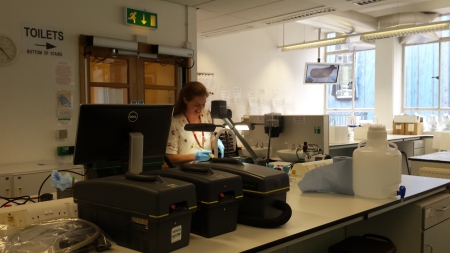I wanted to be an Archaeologist when I was 11, and this was certainly down to a fascination with the bones of animals. My inspiration from a very young age came from the wonderful series of ‘Funny Bones’ books by Allan and Janet Ahlberg. The skeletons certainly made me think about how the bones of humans and animals (admittedly not 100% accurate) moved together. I trace my later interest to the many books on dinosaurs and prehistoric life that I assiduously read in my school library. Fast forward 20 years and as an intern at Auckland War Memorial Museum in 2012, I was allowed to ‘have a go’ at preparing some native birds for skeletonisation by de-fleshing them. At Exeter’s Royal Albert Memorial Museum, I worked on a small project to re-house some Moa bones whose storage and provenance needed to be updated. However, I wasn’t aware of the methods to clean and maintain bone and re-mount skeletal collections in museums.
I was therefore pleased when NatSCA and conservators from the Cambridge Museum of Zoology put together an amazing conference and workshop called ‘Bone Collections: using, conserving and understanding osteology in museums’. Depending on your area of interest, you could attend for some or all of the talks, or take part in a bone cleaning workshop hosted by Bethany Palumbo, Conservator at Oxford University Museum of Natural History, and Vicky Singleton and Natalie Jones of Cambridge University Museums. By taking part, I was able to gain some practical hands on experience of handling and observing bones in collections, and using a variety of dry and wet cleaning methods that are recommended as safe to use, easy to apply, and non-invasive.

Bone cleaning in progress (Image: Anthony Roach)
Bethany began by outlining the structure and composition of bone and the impact that light, humidity, and temperature can have on bone if not properly cared for. Bone can become bleached through exposure to light. The surface of bones can crack if they become too hot or suffer mould damage if left in cold, damp conditions. Bethany explained that the bone itself can also cause problems, such as with the secretion of natural fats and oils, which are acidic and can ooze out of specimens long after they have been cleaned and erected for display. This can lead to acid burn. Mechanical damage of bones can also occur, where wire is excessively tight in articulated specimens, or fatty acids react with copper wire and pins to cause Verdigris.

Vicky Singleton, Conservator at Cambridge University Museums pictured demonstrating dry cleaning methods (Image: Anthony Roach)
Vicky Singleton and Natalie Jones then systematically went through the various methods for dry and wet cleaning of bones. The methods for dry cleaning include using a vacuum and brush, smoke sponge, a ‘groom stick’ made of natural rubber, and air. These methods are less time consuming, less invasive, and more cost effective than wet methods. I was able to choose specimens from a box of assorted bones, and see the impact of the methods for myself. I could see the difference literally first hand on the digits of a primate hand, using the various dry methods. I then used the wet methods on a collection of horse vertebrae. The wet methods made a dramatic difference to the surface of the bone. These include using solvents such as de-ionised water, ethanol, and white spirit, enzymes, and detergents (e.g. Synperonic A7). I was amazed by the impact of white spirit on greasy bones, where water made little or no impact. The clear favourite to remove dirt in general was actually something I hadn’t ever considered: human saliva, which is full of enzymes. Human saliva! Who knew?

Bones shown partially cleaned by various solvents including water, ethanol and white spirit, as part of the wet cleaning methods (Image: Anthony Roach)
The talks were equally excellent, such as the session by Paolo Viscardi on the uses of skeletal reference collections at Sheffield University, which consists of over 1800 specimens, organised in a useful way for teaching and research. Jack Ashby’s #BoneIdols talk about the successful crowdsourcing project to protect some of the Grant Museum’s most scientifically important and rare specimens was also inspiring. The quagga, for instance, has became something of a celebrity in its own right through a very successful marketing campaign where visitors could see the conservation, re-mounting, and re-storage of the specimen. Interest was also maintained through press releases and blogs about the Quagga and the use of technology used in museums. Jan Freedman’s ‘Game of Bones’ talk on the methods for preparing animals for skeletonisation and using bone collections was also memorable.
Anthony Roach, Natural History Museum (NHM)











